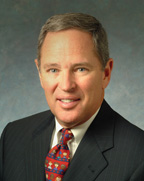
John Meara, Partner, Meara Welch Browne, P.C.
Batting .400 in baseball will get you into the Hall of Fame. Doing it as a wealth adviser will get you into another line of work before the season’s over. So you’d better be good at what you do—and have the creativity and zeal to bounce back and keep those client relationships intact.
Just ask John Meara, a partner in the accounting firm of Meara, Welch, Browne, P.C. “You are not going to believe this,” says Meara, “but I have never had an outcome so bad that a client was super upset. I have had some things not work out, but we have always been able to devise other alternatives that have mitigated the financial damage to the point of insignificance overall.”
So he’s good at what he does—but what he does isn’t what he set out to do early in life. “My Dad was an attorney and I wanted to be an attorney,” Meara says. He paved his path to UMKC’s law school with degrees in accounting and computer science, working his way through college at a CPA firm in Illinois.
After arriving in Kansas City, he took a gig at Price Waterhouse & Co. to pay the bills. “I loved my work and felt I was practicing tax law,” he says, but after three semesters of night classes at UMKC, “I knew I was meant for accounting.” Here’s one reason why: “I started at PW at $9,600 plus overtime; new lawyers at Stinson Mag (the largest firm in town at the time) started at $6,000 to $7,200, no overtime.” As they say in court, “case closed.”
In addition to his financial advisory services, Meara is highly regarded as an expert witness in cases involving financial fraud.
Earlier this year, his firm left its longtime digs on the Country Club Plaza for the Kansas side and Leawood, a real-life consequence of public-policy decisions. When Kansas revamped its tax code to encourage more small business ownership last year, it became nearly impossible to offer clients good-faith advice suggesting that they could do better by locating in Missouri. He and his partners practiced what they preached. “It was very difficult for a KC firm of 35 years to change its primary location,” he says, but in the end, the Kansas economic incentives, combined with the cuts in income tax rates, made staying put a financially unsound choice. The state line, he says, “was an invisible barrier that has proven illusive, if not non-existent.”
The successes he’s enjoyed have allowed Meara and his wife, René, to contribute in meaningful ways to dozens of philanthropic causes over the years, and most recently in promoting Just Like You Films, which produces programs that raise awareness of issues confronting children with severe burn injuries or illnesses.

Jerry Kelly, Silpada Designs
Jerry Kelly remembers it like it was yesterday: Late 2001. For nearly a decade, he and his wife, Bonnie, along with partner Teresa Walsh, have forged a working business model out of a series of home silver-jewelry parties. They called it Silpada Designs. “By year’s end 2001, we projected our annual revenues to hit $2 million,” Kelly recalls. “But they hit $3 million, with much of that additional revenue growth coming in the fourth quarter.” Tough problem, right? Actually, it was. “That unexpected extra growth, in such a short period of time, caused operational nightmares,” Kelly says—backorders nearing 20 percent, customers on hold for an hour trying to reach one of the two customer-service representatives. “The entire company, all 18 of us, were working around the clock” to fill representatives’ orders during those critical months at year’s end.
Fittingly, that Christmas season brought an epiphany. “Bonnie, Teresa and I determined that we had to be extremely aggressive in getting out ahead of the growth,” Kelly says, or face irreparable harm to the company. With a substantial line of credit from Security Bank, they hired 25 employees, built their first corporate headquarters and fulfillment center, and developed software that allowed representatives to enter party orders online.
The rest, as they say, is entrepreneurial history. Over the next eight years, revenues surged to more than $200 million. And in 2010, they sold Silpada to Avon for $650 million. That’s a fairly decent return on the original $50 investment that “the girls” made by raiding their household grocery budgets in 1992. By 1997, “Bonnie, Teresa and I were each 42 years old,” Kelly says, and he was the general manager of a sporting goods catalog company, making a decent income. “So when we decided to make the leap and refinance our home to help start Silpada, there was certainly risk for both the Kelly and Walsh families. It was a huge decision.” Each family, he says, had three children under 17, with no guarantees of success. But the girls would handle the jewelry and sales strategies; Jerry would oversee business operations as CEO. It was a risk, but one calculated on a proven concept. And it worked.
The sale allowed both families to create philanthropic foundations, with their own goals. And Silpada and its representatives have embraced the Juvenile Diabetes Research Foundation, raising nearly $2 million for it since 2007. After passing the CEO’s reins to Tom Kelly—no relation—Jerry remains Silpada’s chairman and continues to work on strategic initiatives. Bonnie and Teresa still lead the design and product-development strategy, cultivating their relationships with Silpada representatives across North America. “This company remains our baby,” says Kelly, and “its 30,000 representatives are ‘our girls.’”